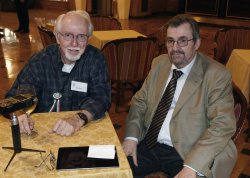
Ron Lake, born in 1941, a native of Illinois, started working very early in the field of mechanics, becoming a prototype construction manager in a car and aerospace company in a short time. In 1965 he built a small workshop in his garage and so his legend began. In 1971, he entered the US Knifemakers' Guild and decided to spend full time working on his knives.
Today, Ron Lake is considered one of the fathers of modern cutlery and although he no longer accepts orders for new knives, he runs international fairs.
We have had the pleasure of meeting him at the last edition of the exhibition of artistic and custom knives organized by the Italian Knifemakers' Corporation in Milan and we interviewed him exclusively for www.all4shooters.com
Mr Lake, you started making knives more than 40 years ago. How has the way of making knives changed since then?
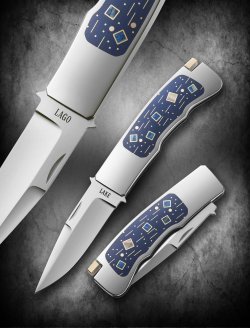
In fact it's 51 years that I'm making knives ... However, basically it's the same except people have better equipment. The way to make knives has not changed much. What's completely different is the machinery. Today there are belt grinders and milling machines, but once they were not used.
I was the first member of the Knifemakers' Guild to own a milling machine.
At that time, everybody used cutoff wheels to cut the bodies of steel and body grinders to start grinding. So a lot of things evolved because of machinery. Every year from the beginning of the Guild in 1970-71 the craftsmanship and techniques have grown like this. Now it's a little leveled off, a lot of the styles began to overlap one another. Years ago you could tell every knifemaker's knife from a distance, today it's a kind of difficult. It's all a bit more blurred.
What advice would you give to a young man who wants to start a career as a knifemaker today?
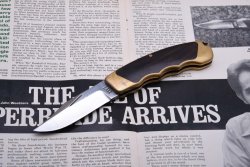
I would say: don't have big hopes. Because today it is very, very easy to become a knifemaker, but it's difficult to stay a knifemaker.
When I started there was no market, no knife shows at all. True, you might take a table at a gun show, but if you asked thirty or thirty-five dollars for a knife, people laughed in your face
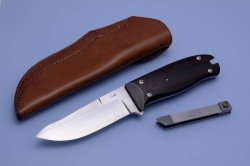
Now the market is huge, but there is also a lot of competition. So even if everything has changed, the difficulty of making a knife is basically the same; you just have to make sure your quality is compatible with the price. I remember going to a German show many years ago, and there was one maker who tried to sell his knives at a very high price, 800-900 German marks (about 4-500 Euros present).
He didn't sell any knife. I said, "You just started making knives, why don't you lower the price?"
He replied, "But I got so many hours in these!" I said, "You're going in the school now. You've got to pay for your education, don't expect them to pay for it."
So the next day he lowered the prices to 25 marks, but he didn't sell any knife. I never saw the guy again. He just disappeared.
It was not his destiny to be a knifemaker...
See, I tell people there are two "D": the desire - that is in your head - and the determination in your stomach. It is the determination that makes you work all night to finish a job and makes you leave at five in the morning to fly to a Paris knife show. But sometimes it is difficult to do all that while maintaining the same quality of work.
Do you think the golden age for artistic knives has passed or is the best yet to come?
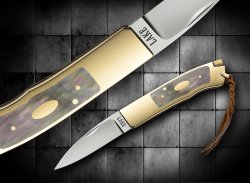
Oh, the best is yet to arrive, always. If you look at the first folding knives I've made they look to be garbage compared to the quality now, but at the time they looked like rocket science.
I was the first in the Guild to make folding knives when at that time people thought that they should cost less than a fixed-blade knife. And we're talking about a time when you bought a Buck folder with 4.99 dollars, and a Loveless fighter costed 115 dollars. So I sold my folding knives at 115 dollars as well.
What's the most rewarding thing in being a famous knifemaker like you?
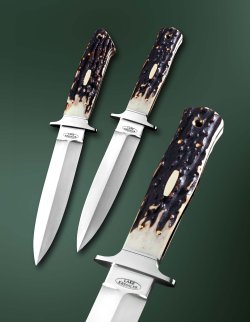
For me, being able to work at home watching me grow my children, being free to decide when to start and finish working. But the really rewarding thing is not the money, it's the people I've met. I really have met nice people.
Obviously, sometimes I also encounter some idiot, but it happens in every walk of life. I like people and I like to treat everyone the same way. I happened to meet people who had a lot of money and for this they expected to be treated better than others, but with me it does not work. I'll never make a knife faster than I need, even if they pay me twice. If you do

One day, somebody asked me, "Why are your knives so expensive?" I told him the same as I told a lady in Paris at the first edition of the Paris show, at Mercur Hotel.
I remember this well dressed girl, she was eighteen. She started looking at the tables and then coming to my table she asked me, "Mr Lake, I'd like to know why your knives are so expensive" I said, "Because my name is on it." And it's still true.
Even in Japan today. I asked a knife dealer: what are you selling in Japan? "Loveless and Lake," he replied. "Because of the name." There are people who can probably make as good or better knives than mine, but it takes time to build a reputation.
Which are the three most important things in building a knife?
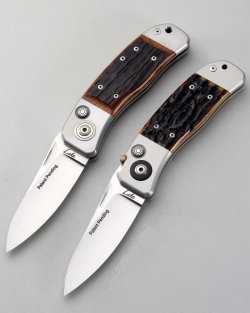
First of all the materials, meaning both the grip and the blade material. Then the way these are coupled to each other.
Blades must undergo the appropriate heat treatment: if you use a good quality stainless steel, you cannot heat it in a normal oven and expect good results.
Then there is good craftsmanship.
You can have good craftsmanship, you can have very high-quality craftsmanship, you can have excellent craftsmanship.
I don't mind somebody making a knife that just got four hundred finish on the blade, good steel but has a low price: I respect that.
So when you move up in quality you also have to get a price increase and people have to understand that. It is difficult to make a living making knives.
It's easy to make a knife, but it's difficult to make a living making the knives.
The last thing is already evident: build a reputation. Make your name important. When you look at the name on my knives, you can read my name. All knife manufacturers mark the blade with the letters one hundred and eighty degrees the other direction. Somebody asked me, "Why do you mark your knives backwards?" I replied, "Actually it's not backwards, because you give the knife to a sport writer and you know he will stick it in a log like this. Now you may read my name." Bill Moran heard me explain this in 1972, after that he always marked the knives as I do. The best advertising is the free advertising!
To learn more: www.lakeknives.com










